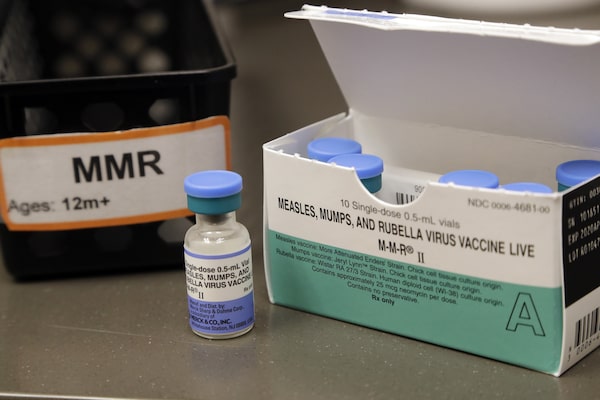With Canada’s colder weather comes respiratory virus season, with flus and RSV circulating alongside the COVID-19 virus that remains with us. While Canadians learned a lot about how to protect themselves from illness over the course of the pandemic, new information released by health care practitioners can help inform decisions, from availability of flu shots to any changes in COVID protocols.
We’ll be publishing an update on respiratory virus season each week. Looking for more information on the topic that you don’t see here? Email audience@globeandmail.com to see if we can help you.

A dose of the measles, mumps and rubella vaccine is displayed at a high school in Vashon Island, Wash., on May 15, 2019.Elaine Thompson/The Associated Press
The latest news
- The U.S. Centers for Disease Control and Prevention says the respiratory virus season is past its peak, but that it isn’t over, meaning it’s still important to take protective measures to prevent the spread of illness.
- At least five cases of measles have been confirmed in Canada so far this year, raising concern about the possibility of outbreaks because of lower vaccination rates. The five cases include an infant currently in the hospital who appears to have become infected on an international trip, according to Toronto Public Health. Measles no longer spreads in Canada, but when cases are introduced from out-of-country travel they have the potential to spread and lead to outbreaks. Vaccination rates need to be at 95 per cent to ensure community protection, but those have been slipping since the pandemic. For instance, only 74 per cent of seven-year-olds in Alberta had two doses of the measles, mumps and rubella vaccine in 2022, down from 80 per cent in 2019.
Flu shots
Flu shot clinics and programs are ramping up across the country, and appointments are being made available for anyone six months or older. Find out about clinics and availability for each of the provinces and territories here:
Newfoundland; Prince Edward Island; Nova Scotia; New Brunswick; Quebec; Ontario; Manitoba; Saskatchewan; Alberta; British Columbia; Yukon; Northwest Territories; Nunavut
COVID boosters
The three authorized vaccines, manufactured by Pfizer-BioNTech, Moderna and Novavax, protect against the XBB.1.5 subvariant of COVID-19 and should provide good protection against the related EG.5 family. The reformulated mRNA shots from Pfizer-BioNTech and Moderna are approved for anyone six months or older. Novavax’s shot is approved for those 12 and up.
COVID-19 vaccine information for the provinces and territories can be found here:
Newfoundland; Prince Edward Island; Nova Scotia; New Brunswick; Quebec; Ontario; Manitoba; Saskatchewan; Alberta; British Columbia; Yukon; Northwest Territories; Nunavut
Flu outlook in Canada
Flu activity in Canada is at or below expected levels for this time of year, according to the Public Health Agency of Canada’s most recent FluWatch report. B.C. and Ontario are the only regions that reported widespread flu activity during the week that ended Feb. 10.
From Aug. 27 to Feb. 10, there were 3,606 flu-related hospital admissions reported to PHAC, with people 65 or older accounting for 49 per cent of them. Adults 65 or older and children under five have the highest rates of hospital admissions for the flu in Canada.
PHAC changed the way it collects pediatric flu data this season. So far, it has not released data on intensive-care-unit admissions or flu-related deaths in children in Canada.
During the week that ended Feb. 10, there were 30 flu-related hospital admissions in children. So far this season, 577 children have been admitted to hospital as a result of influenza, according to PHAC.
Hospitalization for COVID
According to PHAC, COVID-19 activity is stable or decreasing across the country. During the week that ended Feb. 14, there were 2,825 patients in hospital as a result of COVID-19 in Canada, compared to 3,027 the week before. Of those, 121 were in intensive-care units.
Current health guidance for COVID
Symptoms of COVID-19 can vary, but generally include sore throat, runny nose, sneezing, new or worsening cough, shortness of breath or difficulty breathing, feeling feverish, chills, fatigue or weakness, muscle or body aches, new loss of smell or taste, headache, abdominal pain and diarrhea. According to Health Canada, people may start experiencing symptoms anywhere from one to 14 days after exposure. Typically, symptoms appear between three to seven days after exposure.
Health Canada advises following the testing guidelines provided by your local public health authority if you have symptoms or have been exposed to a person with COVID-19. If you test positive, immediately isolate yourself from others, including those in your household, and follow the advice of your local public health authority on isolation requirements.
How to protect yourself and your loved ones from respiratory viruses
Respiratory viruses are spread from person to person or through contact with contaminated surfaces, so it’s important to protect against both forms of transmission. Health Canada recommends wearing a medical mask or respirator, washing your hands regularly or using hand sanitizer, covering your coughs and sneezes, and cleaning and disinfecting high-touch surfaces and objects. If you feel sick, stay home and limit contact with others.
 Carly Weeks
Carly Weeks